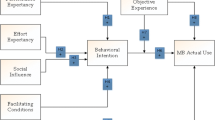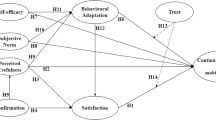Abstract
Higher penetration of smartphones and 3G and 4G mobile networks have led to the higher usage of smartphones for mobile banking activities. This paper identifies key antecedents influencing the mobile banking acceptance. The research extends the original Technology Acceptance Model, by incorporating two cognitive antecedents, namely, autonomous motivation and controlled motivation, in addition to trust components for understanding adoption. Data were collected from 225 mobile banking users and analyzed using an innovative two-stage research methodology. In the first stage, structural equation modeling was employed to test the research hypotheses and identify significant antecedents influencing mobile banking acceptance. In the second stage, the significant antecedents obtained from the first stage were input to a neural network model for ranking. The results showed that trust and autonomous motivation are the two main predictors influencing mobile banking acceptance. Theoretical and practical implications of findings are discussed.


Similar content being viewed by others
References
Adams, D. A., Nelson, R. R., Todd, P., & A. (1992). Perceived usefulness, ease of use and usage of information technology: A replication. MIS Quarterly, 16(2), 227–247.
Akturan, U., & Tezcan, N. (2012). Mobile banking adoption of the youth market. Marketing Intelligence & Planning, 30(4), 444–459.
Alalwan, A. A., Dwivedi, Y. K., Rana, N. P., & Simintiras, A. C. (2016). Jordanian consumers' adoption of telebanking: Influence of perceived usefulness, trust, and self-efficacy. International Journal of Bank Marketing, 34(5), 690–709.
Alalwan, A. A., Dwivedi, Y. K., & Rana, N. P. (2017). Factors influencing adoption of mobile banking by Jordanian bank customers: Extending UTAUT2 with trust. International Journal of Information Management, 37(3), 99–110.
Barati, S., & Mohammadi, S. (2009). An efficient model to improve customer acceptance of mobile Banking. Proceedings of the world congress on engineering and computer Science, vol II WCECS, October 20–22, 2009, San Francisco.
Bellenger, D. N., & Korgaonkar, P. (1980). Profiling the recreational shopper. Journal of Retailing, 56(3), 77–82.
Bremer, C. (2012). New format for online courses: The open course future of learning. Proceedings of eLearning Baltics eLBa, 2012, 63–90.
Brown, I., Cajee, Z., Davies, D., & Stroebel, S. (2003). Cell phone banking: Predictors of adoption in South Africa-an exploratory study. International Journal of Information Management, 23(5), 381–394.
Chang, S. C., & Tung, F. C. (2008). An empirical investigation of students' behavioural intentions to use the online learning course websites. British Journal of Educational Technology, 39(1), 71–83.
Chong, L.-Y. A. (2013). A two staged SEM-neural network approach for understanding and predicting the determinants of m-commerce adoption. Expert Systems with Applications, 40, 1240–1247.
Chong, A. Y. L., Chan, F. T., & Ooi, K. B. (2012). Predicting consumer decisions to adopt mobile commerce: Cross country empirical examination between China and Malaysia. Decision Support Systems, 53(1), 34–43.
Chong, A. Y. L., Liu, M. J., Luo, J., & Keng-Boon, O. (2015). Predicting RFID adoption in healthcare supply chain from the perspectives of users. International Journal of Production Economics, 159, 66–75.
Dai, H., & Palvi, P. C. (2009). Mobile commerce adoption in China and the United States: A cross-cultural study. ACM SIGMIS Database, 40(4), 43–61.
Davis, F. D. (1989). Perceived usefulness, perceived ease of use, and user acceptance of information technology. MIS Quarterly, 13(3), 319–340.
Davis, F. D., Bagozzi, R. P., & Warshaw, P. R. (1989). User acceptance of computer technology: A comparison of two theoretical models. Management Science, 35, 982–1003.
De Naeghel, J., Van Keer, H., Vansteenkiste, M., Haerens, L., & Aelterman, N. (2016). Promoting elementary school students' autonomous reading motivation: Effects of a teacher professional development workshop. The Journal of Educational Research, 109(3), 232–252.
Deci, E. L., & Ryan, R. M. (2002). Handbook of self-determination research. University Rochester Press.
Delone, W. H., & McLean, E. R. (2003). The DeLone and McLean model of information systems success: A ten-year update. Journal of Management Information Systems, 19(4), 9–30.
Drewes, D. W. (2000). Beyond the spearman-Brown: A structural approach tomaximal reliability. Psychological Methods, 5, 214–227.
Fishbein, M., & Ajzen, I. (1975). Belief, Attitude, Intention and Behavior: An introduction to Theory and Research. Addison-Wesley, Reading.
Gagne, P., & Hancock, G. R. (2006). Measurement model quality, sample size, and solution propriety in confirmatory factor models. Multivariate Behavioral Research, 41(1), 65–83.
Goodhue, D. L., & Thompson, R. L. (1995). Task-technology fit and individual performance. MIS Quarterly., 19, 213–236.
Gu, J. C., Lee, S. C., & Suh, Y. H. (2009). Determinants of behavioral intention to mobile banking. Expert Systems with Applications, 36(9), 11605–11616.
Guàrdia, L., Maina, M., & Sangrà, A. (2013). MOOC design principles: A pedagogical approach from the learner’s perspective. eLearning Papers, 33,1–6.
Gulf News (2015). GCC Banks lag in Smart-Phone Banking and Digital Customer Experience. http://gulfnews.com/business/sectors/banking/gcc-banks-lag-in-smartphone-banking-and-digital-customer-experience-1.1620262. Accessed 15 Nov 2015.
Hagger, M. S., Chatzisarantis, N. L., & Biddle, S. J. (2002). A meta-analytic review of the theories of reasoned action and planned behavior in physical activity: Predictive validity and the contribution of additional variables. Journal of Sport & Exercise Psychology, 24(1), 3–32.
Hair, J. F., Anderson, R. E., Babin, B. J., & Black, W. C. (2010). Multivariate data analysis: A global perspective (Vol. 7). Upper Saddle River: Pearson.
Hanafizadeh, P., Behboudi, M., Koshksaray, A. A., & Tabar, S. J. M. (2014). Mobile banking adoption by Iranian bank clients. Telematics & Informatics, 31, 62–78.
Hartnett, M. K. (2015). Influences that undermine learners’ perceptions of autonomy, competence and relatedness in an online context. Australasian Journal of Educational Technology, 31(1), 86–99.
Haykin, S. S. (2001). Neural networks: A comprehensive foundation. Beijing: Tsinghua University Press.
Kapoor, K. K., Dwivedi, Y. K., & Williams, M. D. (2015). Examining the role of three sets of innovation attributes for determining adoption of the interbank mobile payment service. Information Systems Frontiers, 17(5), 1039–1056.
Kim, H. W., Chan, H. C., & Gupta, S. (2007). Value-based adoption of mobile internet: An empirical investigation. Decision Support Systems, 43(1), 111–126.
Laukkanen, T., & Kiviniemi, V. (2010). The role of information in mobile banking resistance. International Journal of Bank Marketing, 28(5), 372–388.
Lee, Y., Lee, J., & Hwang, Y. (2015). Relating motivation to information and communication technology acceptance: Self-determination theory perspective. Computers in Human Behavior, 51, 418–428.
Liébana-Cabanillas, F., Sánchez-Fernández, J., & Muñoz-Leiva, F. (2014). The moderating effect of experience in the adoption of mobile payment tools in virtual social networks: The m-payment acceptance model in virtual social networks (MPAM-VSN). International Journal of Information Management, 34(2), 151–166.
Liébana-Cabanillas, F., Marinković, V., & Kalinić, Z. (2017). A SEM-neural network approach for predicting antecedents of m-commerce acceptance. International Journal of Information Management, 37(2), 14–24.
Lin, F. H. (2011). An empirical investigation of mobile banking adoption: The effect of innovation attributes and knowledge based trust. International Journal of Information Management, 31, 252–260.
Luarn, P., & Lin, H. H. (2005). Toward an understanding of the behavioral intention to use mobile banking. Computers in Human Behavior, 21(6), 873–891.
Luo, X., Li, H., Zhang, J., & Shim, J. P. (2010). Examining multi-dimensional trust and multi-faceted risk in initial acceptance of emerging technologies: An empirical study of mobile banking services. Decision Support Systems, 49(2), 222–234.
Malaquias, F. R., & Hwang, Y. (2016). An empirical study on trust in mobile banking: A developing country perspective. Computers in Human Behavior, 54, 453–461.
Mallat, N., Rossi, M., Tuunainen, V. K., & Öörni, A. (2009). The impact of use context on mobile services acceptance: The case of mobile ticketing. Information Management, 46(3), 190–195.
Michou, A., Matsagouras, E., & Lens, W. (2014). Dispositional achievement motives matter for autonomous versus controlled motivation and behavioral or affective educational outcomes. Personality and Individual Differences, 69, 205–211.
Nikou, S. A., & Economides, A. A. (2017). Mobile-based assessment: Integrating acceptance and motivational factors into a combined model of self-determination theory and technology acceptance. Computers in Human Behavior, 68, 83–95.
O’Connor, Y., & O’Reilly, P. (2016). Examining the infusion of mobile technology by healthcare practitioners in a hospital setting. Information Systems Frontiers, 1–21.
Riffai, M. M. M. A., Grant, K., & Edgar, D. (2012). Big TAM in Oman: Exploring the promise of on-line banking, its adoption by customers and the challenges of banking in Oman. International Journal of Information Management, 32(3), 239–250.
Ryan, R. M., & Deci, E. L. (2000). Intrinsic and extrinsic motivations: Classic definitions and new directions. Contemporary educational psychology, 25(1), 54–67.
Ryan, R. M., & Deci, E. L. (2000). Self-determination theory and the facilitation of intrinsic motivation, social development, and well-being. American Psychologist, 55(1), 68.
Shaikh, A. A. (2013). Mobile banking adoption issues in Pakistan and challenges ahead. Journal Institute Bankers Pakistan, 80(3), 12–15.
Shaikh, A. A., & Karjaluoto, H. (2015). Mobile Banking adoption: A literature review. Telematics and Informatics, 32, 129–142.
Sharma, S. K., Joshi, A., & Sharma, H. (2016). A multi-analytical approach to predict the Facebook usage in higher education. Computers in Human Behavior, 55, 340–353.
Shmueli, G., & Koppius, O. R. (2011). Predictive analytics in information systems research. MIS Quarterly, 35, 553–572.
Sim, J. J., Tan, G. W. H., Wong, J. C., Ooi, K. B., & Hew, T. S. (2014). Understanding and predicting the motivators of mobile music acceptance–a multi-stage MRA-artificial neural network approach. Telematics and Informatics, 31(4), 569–584.
Sinha, P. K. (2003). Shopping orientation in the evolving India market. The Journal of Decision Makers, 28(2), 13–22.
Sripalawat, J., Thongmak, M., & Ngramyarn, A. (2011). M-banking in metropolitan Bangkok and a comparison with other countries. Journal of Computer Information System, 51(3), 67–76.
Suoranta, M., & Mattila, M. (2004). Mobile banking and consumer behavior: New insights into the diffusion pattern. Journal of Financial Services Marketing, 8(4), 354–366.
Tam, C., & Oliveira, T. (2016). Understanding the impact of m-banking on individual performance: DeLone & McLean and TTF perspective. Computers in Human Behavior, 61, 233–244.
Telecommunication Regulatory Authority Report (2016). https://www.tra.gov.om/pdf/q2-2016.pdf. Accessed on 03 Nov 2016.
TOO (2016). http://timesofoman.com/article/84406/Business/Oman's-banking-sector-achieves-robust-growth-despite-oil-price-slump. Accessed 03 Nov 2016.
Vansteenkiste, M., Neyrinck, B., Niemiec, C. P., Soenens, B., Witte, H., & Broeck, A. (2007). On the relations among work value orientations, psychological need satisfaction and job outcomes: A self-determination theory approach. Journal of Occupational and Organizational Psychology, 80(2), 251–277.
Venkatesh, V., & Davis, F. D. (2000). A theoretical extension of the technology acceptance model: Four longitudinal field studies. Management Science, 46(2), 186–204.
Venkatesh, V., Morris, M. G., Davis, G. B., & Davis, F. D. (2003). User acceptance of information technology: Toward a unified view. MIS Quarterly, 27, 425–478.
Wang, Y. M., & Elhag, T. M. (2007). A comparison of neural network, evidential reasoning and multiple regression analysis in modelling bridge risks. Expert Systems with Applications, 32(2), 336–348.
Wang, Y. S., Wu, M. C., & Wang, H. Y. (2009). Investigating the determinants and age and gender differences in the acceptance of mobile learning. British journal of educational technology, 40(1), 92–118.
Wessels, L., & Drennan, J. (2010). An investigation of consumer acceptance of M- banking. International Journal of Bank Marketing, 28(7), 547–568.
Yadav, R., Sharma, S. K., & Tarhini, A. (2016). A multi-analytical approach to understand and predict the mobile commerce adoption. Journal of Enterprise Information Management, 29(2), 222–237.
Yu, T. K., & Fang, K. (2009). Measuring the post-adoption customer perception of mobile banking services. Cyberpsychology & Behavior, 12(1), 33–35.
Zhang, L., Zhu, J., & Liu, Q. (2012). A meta-analysis of mobile commerce adoption and the moderating effect of culture. Computers in Human Behavior, 28(5), 1902–1911.
Zhou, T. (2011). An empirical examination of initial trust in mobile banking. Internet Research, 21(5), 527–540.
Zhou, T. (2012). Understanding users’ initial trust in mobile banking: An elaboration likelihood perspective. Computers in Human Behavior, 28, 1518–1525.
Zhou, M. (2016). Chinese university students' acceptance of MOOCs: A self-determination perspective. Computers & Education, 92, 194–203.
Author information
Authors and Affiliations
Corresponding author
Appendices
Appendix 1
Appendix 2
Rights and permissions
About this article
Cite this article
Sharma, S.K. Integrating cognitive antecedents into TAM to explain mobile banking behavioral intention: A SEM-neural network modeling. Inf Syst Front 21, 815–827 (2019). https://doi.org/10.1007/s10796-017-9775-x
Published:
Issue Date:
DOI: https://doi.org/10.1007/s10796-017-9775-x




